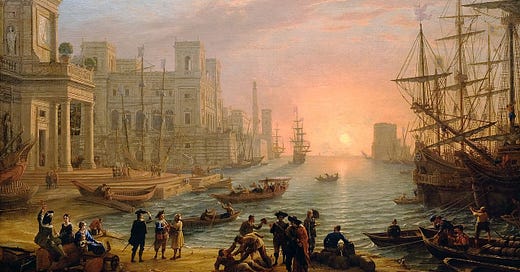Welcome to Cosmographia. This post is part of our Cartography of Networks series. For the full map of posts, see here.
Today, the volume of maritime trade sailing the Mediterranean Sea exceeds 800 billion tonne-km per year. This is not a new phenomenon; the cargo ships, oil tankers, and bulk carriers that today crisscross the ancient inland sea are just the latest iteration of vessels engaging in a practice that has its origin in the farthest reaches of antiquity.
The Bronze Age (3300 — 1200 BC) saw the Greek Mycenaeans trading across the Med with the Egyptians, who in turn traded with the Hittites of Anatolia. The collapse of the former was in part caused by the invasions of the mysterious Sea Peoples who sailed from the Balkans to topple mighty Mycenae on the Peloponnese peninsula, and cause chaos across the shores of the Eastern Mediterranean wherever they beached their bird-headed prows, from Egypt to Syria. Later, Homer would sing of the Achaean “black-bellied ships” used to carry the invading army to the walls of Troy, while his sequel epic, the Odyssey, would tell of Odysseus’ meandering voyage across almost all of the Mediterranean, a sea which had long been familiar to his Iron Age Greek audience, who had been busy establishing trading colonies all along the southern European seaboard for centuries. This brought them into regular contact with the greatest seafarers of all antiquity — the Phoenicians, and their subsequent daughter colony, Carthage.
But the apogee of ancient Mediterranean trade was only reached when an Italic city of humble origin had through blood and ruin brought to heel the entire coastline of the sea they called Mare Nostrum (Our Sea), a feat so remarkable that it has never been repeated.


Roman Lake
Three millennia ago Rome was just one humble village among many in Central Italy. Its militaristic culture and inability to ever accept defeat saw the Romans leverage their position on the Italian peninsula, jutting out as it does into the heart of the Mediterranean, to unite the edges of three continents into a single polity.
We often think of Rome as a European phenomenon, but it is perhaps more apt to characterise the Eternal City as a Mediterranean power, for the sea lay at the heart of her territory, and everything she did. All roads really did lead to Rome, with goods, labour, artisans, slaves, and money drawn inexorably to the centre, all of which was facilitated by the maritime might of the Republic-turned-Empire.
This naval supremacy had been hard-won; the Romans had fought three punishing wars against the old hegemonic maritime power of the Western Mediterranean, Carthage, eventually destroying their rival so totally that some historians have called it ‘history’s first genocide.’ The same year (146 BC) saw the decimation of the ancient city of Corinth, sending a clear message to the other traditional sea-faring power of the Mediterranean, the Greeks: submit to Roman rule, or die. It was another century before the rich textile-making towns of Phoenicia fell, and subsequently, after the War of Actium, Egypt was brought into the orbis romanus too. We’ve already seen the effects of these conquests on Roman trade with the Far East, but what of the intra-empire trade across the Mediterranean?
The class divisions between the wealthy patrician elites, who owned enormous estates, and the plebeians and slaves who worked them, created the conditions for enormous surpluses of specialised goods to be produced all over the empire. Papyrus and cotton were produced in Egypt, olive oil in Libya, gold in Iberia, glass in Syria, pottery in Gaul, wine in Italy, and tin flowed south from Britain. Specialised production requires long distance trade and the Mediterranean acted as the nexus of the Roman trade network. With the edges defined by prevailing winds, the key nodes were port cities like Ostia, Carthage, Messana, Alexandria, Corinth, Narbo, Rhodes, and Seleucia. Almost all of these cities were the former trading colonies of Rome’s vanquished enemies — whether Greek, Carthaginian, or Phoenician — showing the extent to which the Romans co-opted, and then turbocharged, already existing commercial patterns. With trade now unencumbered by great power rivalries, the Mediterranean was awash in goods like never before, and Rome and her elites grew exceedingly wealthy.

Though the Roman proficiency for war had won them their empire, their ability to keep it lay not in brute force alone. Rome had been multicultural since its earliest days,1 assimilating its defeated enemies, both elites and not,2 into its citizenship in a way not hitherto seen in the ancient world. While the cruel Assyrians had been torn apart by their oppressed subjects as soon as they were given the chance, Rome ensured almost all its conquered peoples adopted a “if you can’t beat them, join them” attitude to their new overlords.
This open cosmopolitanism was vital not just for bringing together disparate peoples and cultures under a single Roman banner, but also in replenishing the metropolis. Throughout history, cities have been demographic sinks, with poor sanitation, disease, and low fertility all playing their part in necessitating constant replacement from the hinterlands to keep a city stable, let alone grow; Rome was no exception.
Then, like now, some more conservative thinkers didn’t approve of such immigration, necessary and vital though it was. The great satirical poet Juvenal gave voice to this distaste when he wrote: “the Syrian Orontes has long since polluted the Tiber.”
Such xenophobia aside, the Mediterranean trade network was the centre of the Roman world, geographically, politically, and economically, from the Republic’s earliest days to the last gasps of the imperial machine. But as we shall see, the much-fabled Fall of Rome didn’t mean the fall of the network.







